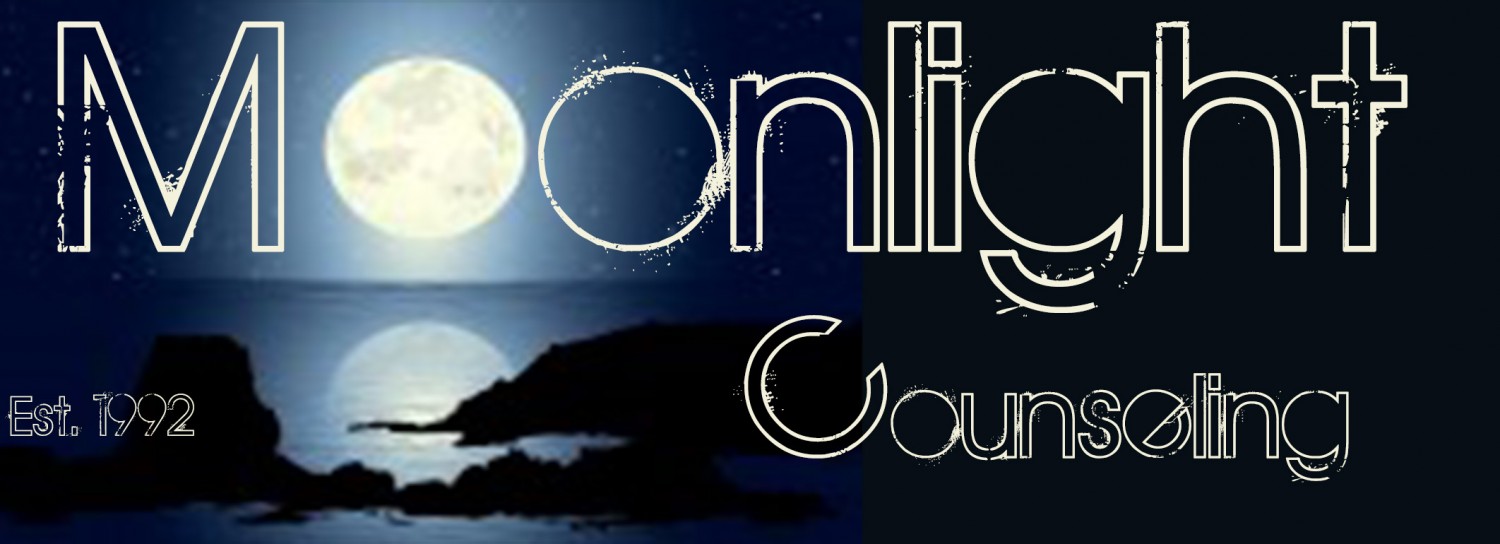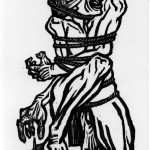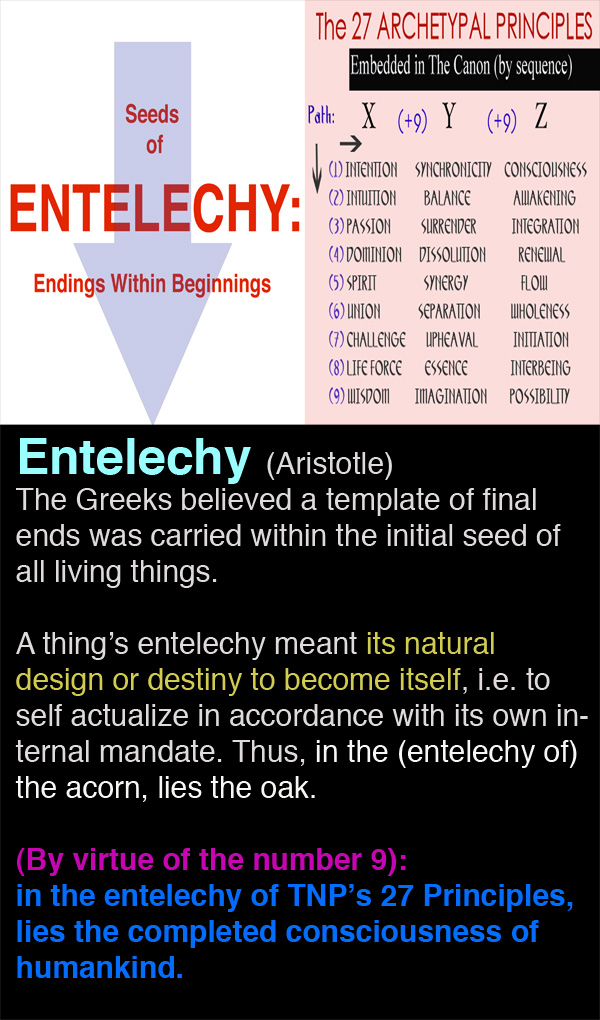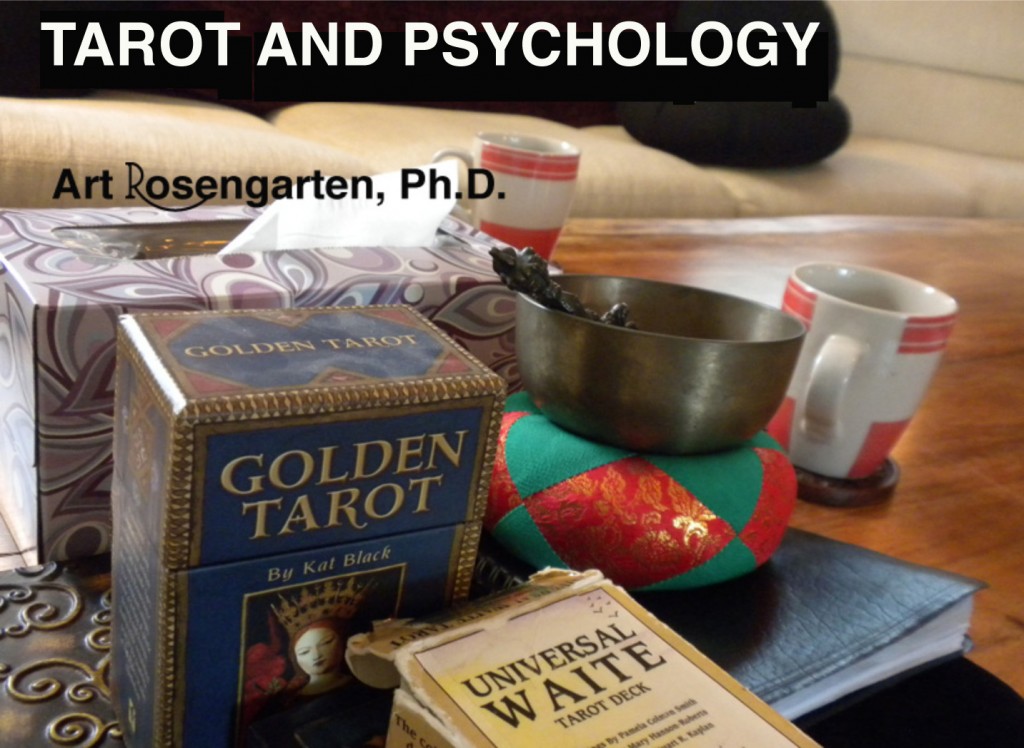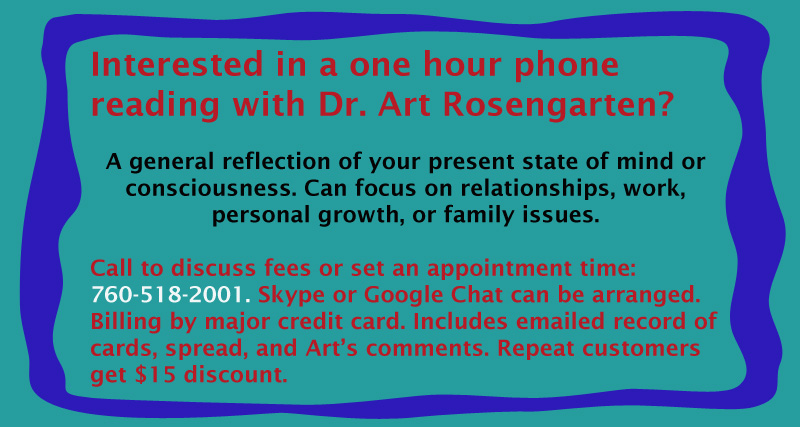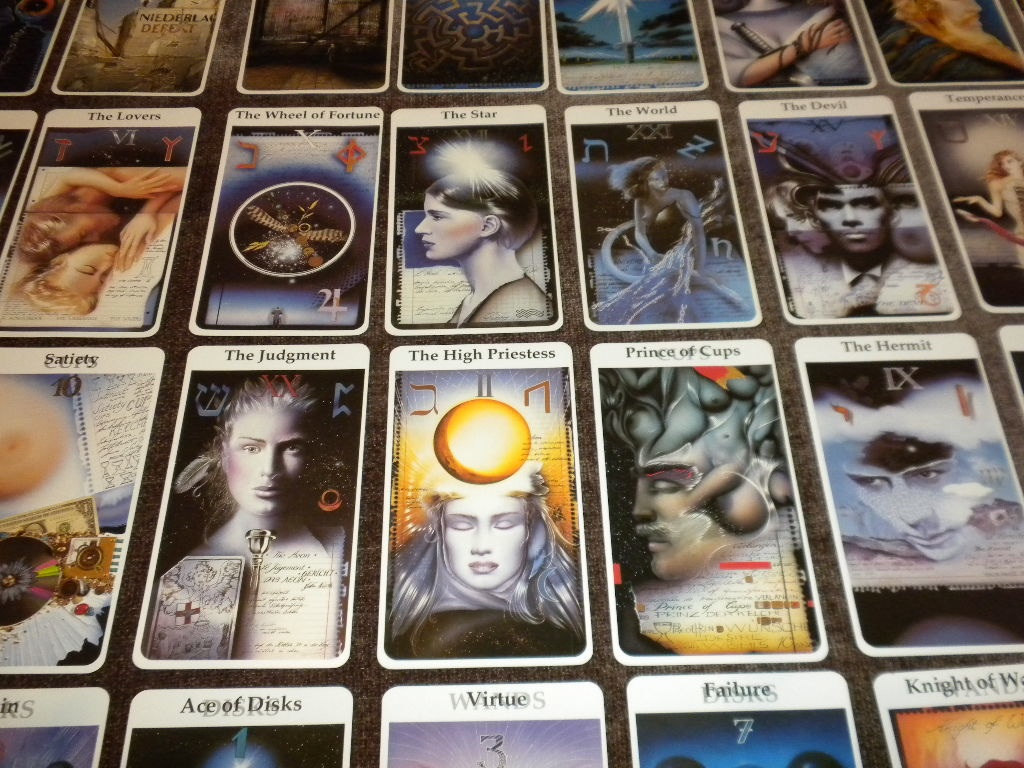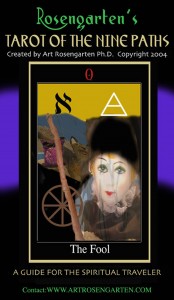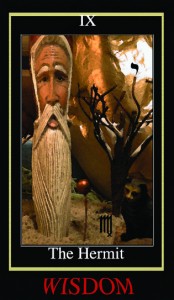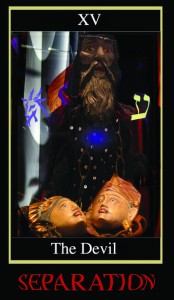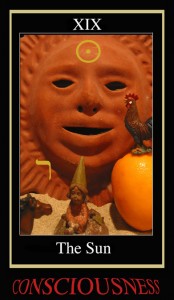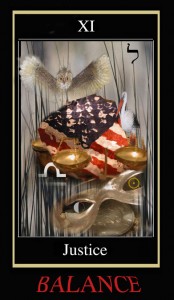-Not A Religion But A Sacred Tool (Essay)
By Art Rosengarten, Ph.D.
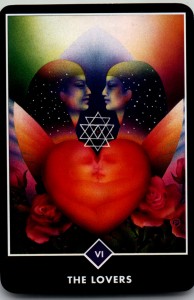 The intuitive and spiritual vision gained from tarot divination, I Ching, numerology, and other such methods remains, even to this day, outright suspect to the spiritual establishment. Established religion asks: Why is there need for these methods when we have already spelled out everything so clearly? Who can be sure that people channeling their own spiritual insight won’t go their own way? As Brother David Steindl-Rast, author, Ph.D., and monk of the Mount Savior Monastery observes:
The intuitive and spiritual vision gained from tarot divination, I Ching, numerology, and other such methods remains, even to this day, outright suspect to the spiritual establishment. Established religion asks: Why is there need for these methods when we have already spelled out everything so clearly? Who can be sure that people channeling their own spiritual insight won’t go their own way? As Brother David Steindl-Rast, author, Ph.D., and monk of the Mount Savior Monastery observes:
“One way or the other, the same plot is acted out repeatedly on the stage of history: every religion seems to begin with mysticism and end up in politics… Fortunately, I have not yet come across a religion where the system didn’t work at all. Unfortunately, however, deterioration begins on the day the system is installed…. Our social structures have a tendency to perpetuate themselves. Religious institutions are less likely than seed pods to yield to the new life stirring within. And although life (over and over again) creates structures, structures do not create life.”(The Mystical Core of Organized Religion, p. 2, 1989)
While the merits of extending good will and warm regard for individuals of differing faiths have evolved to a “hopeful dialogue” at this juncture of planetary change, such progress in the religious and spiritual sectors is usually constrained and offset by the perennially insular practical needs that a particular organization carries for its own survival.
Spreading (or at least keeping) its own faith is a simple matter of endurance, though often and unfortunately it bleeds away energies which might otherwise enliven the creative furthering of an organization’s own vision. Yes charity begins at home, and sure adherence to one’s tradition bears an important function, but a tradition needs to continually renew and develop if it wishes to remain fully alive. The same self-cherishing tendencies, of course, apply to most psychological movements and consciousness-raising programs as well. For all their intelligence and good works, they too tend to calcify within the business of their businesses, and the doctrine of their doctrines. One should not be surprised, therefore, by an almost universal undercurrent of stodgy, “ear wax” sermonettes all in the service of self-preservation and tradition.
Truth be told, most spiritual entities and wisdom enterprises entertain unspoken desires for dominance (hush!) – that is, for becoming the preferred “superbridge” to the world’s great spiritual superhighway – it thus follows, quite logically, that each group in practice would be at best “hesitant,” if not a tad snarly, in its support of the hypothetical “top honor” were it given to any rival group (“OK boys and girls, pack your things — Quakerism is now the universal world practice”), especially if in so doing it meant cementing the quick and painful surcease of their own orders, schools, and doctrines. (Someone has to pay the bills, no?). Human nature being what it is, the politics of organized spirituality as seen on the “world stage” during the 21st century “transition” decade of the 90s was indeed a curious display to behold. The “dirty little secrets” (then and Now) behind ‘The Secret’, I sometimes call it.
The Penultimate Lovefest
As case in point, a number of years ago I had the good fortune to travel to Chicago, Illinois, to attend the auspicious five-day Parliament of World Religions. This by all measures was to be an extraordinary spiritual bonanza, commemorating the 100th anniversary of the great Indian saint, Swami Vivekananda, and his epic journey to America in August of 1893 for the express purpose of initiating the first major “interfaith conference” in recorded history.
The centennial celebration was truly a marvelous event to behold, with every emanation of guru, spiritual ambassador, captain of consciousness, priest and priestess imaginable. The colorful opening ceremony was a procession of Hindus, Buddhists, Native Americans, Sikhs, Jains, Moslems, Rastafarians, B’hais, Yorubans, and Zoroastrians, with women participating on a par with men, and, all in all, creating a truly overwhelming joyous feeling of global spiritual diversity and community.
With more than five thousand attendees filling the luxurious ballrooms of the Palmer Hotel in downtown Chicago, we all were free to pick and choose various talks and instructions given by a virtual smorgasbord of “spiritual bridgemakers” at any given hour (it was worth surrendering your lunch ticket). At this crest of the Clinton Administration, the senior icons of higher spirit and consciousness, many avowed heroes and “rock stars” of the 1960’s Human Potentials Movement, now gathered for the triumphal occasion.
Sublime vision was offered up from the renowned Korean Zen taskmaster Seung Sahn to the gentle Vietnamese Zen poet Thich Nat Hanh. Moral high ground was transmitted from the elegant leader of European Jewry in Sir Sigmund Sternberg to the feisty and controversial leader of African-American Muslims– Reverend Louis Farrakhan (replete with his small army of bodyguards). There were outstanding Christian monks, mystics, and clergy, as well as delegations from three of the largest Pagan organizations in North America. The Joseph Campbell Society was represented, Dr. Jean Houston was there, Arlo Guthrie (and his Brooklyn-born guru) were there, and Harvard professor John Mack, M.D. gave a chilling discussion of his UFO abduction research and theories regarding the interdependence of all beings, earthborn or otherwise.
Yet for so impressive a mandala of spiritual diversity, I don’t believe any speaker throughout the entire affair once mentioned (with the possible exception of the Joseph Campbell group) the incomparable deck of human spiritual possibility itself, that is, the Tarot. As a practical map and instrument of The Great Work itself, I believe there is an important reason for its notable absence in this body: Tarot is not a religion, but a sacred tool. Nor is the Tarot a spiritual movement or a school of consciousness, but a catalyst of imagination and a creator (some may preferinventor) of consciousness. As such, unfortunately, it carries no traction in the official (outer) world dialogue of spirit or consciousness.
A Metaphysical Thermometer
Perhaps some “infusion medicine” might have re-vitalized the competing enterprises of wisdom here? The Tarot, to this end, would be utilized as a gauge of vitality, a transpersonal thermometer of sorts. With its insertion into one of several small physical openings, the traditional thermometer, as we all know, is a diagnostic instrument designed to measure body temperature. Its feedback alerts one to a preliminary and non-specific assessment of multiple, simultaneous, and interrelated systems operating within the physical organism either in health or in sickness.
Curiously, the thermometer’s scientific precursors, technical mechanics, components, internal structure, place of manufacture etc. are entirely secondary (if not irrelevant) to its function. Such technicalities are left to the physicians, producers, and distributors of the product. We just stick it in, pull it out, read it, and wash it (What? You didn’t know that?)– WITHOUT concern for these other irrelevancies. The thermometer’s utility nonetheless remains unrivalled in common medical practice.
So too, we might say, is the Tarot. Its insertion too is placed in one of several small (meta) physical openings—say, a context of exhausted rationality, or perhaps the invocation of a higher power, or a moment of compelling uncertainty that calls out for deeper guidance. Similar to the thermometer, tarot’s feedback alerts one to a non-specific, generalized assessment of structures operating within the whole personality; and interestingly, unlike the thermometer, the Tarot can also be directed to specific systems and subsystems throughout multiple levels of experience, and is comparatively-speaking vastly more versatile.
Practical Spirituality
In terms of “spiritual” matters and organizations, a user my seek to determine, for instance, “Why am I not making spiritual progress after so many years of meditation?” Or perhaps “How can our tradition evolve within the emerging issues and insights of the day?” Or “How can this religion become more experiential and relevant to bright individuals?” Invariably, the cards will point to a unique, multi-layered, set of inter-relationships supplying a complex web of fresh information, ideas, new combinations etc. for introspection as well as corrective action.
As a scion of symbolism, Tarot operates multi-dimensionally from a purely non-affiliated platform in the truest sense. This means anyone can join it, and return to where they are otherwise more traditionally comfortable, yet I believe “improved” by the experience. Tarot is ‘foundationless’ with respect to adherence and fealty to the embedded beliefs of any particular tradition. In the political debates of religion, for instance, liberals and conservatives alike may claim its arcane workings put to the service of their own partisan agendas, but Tarot’s own “vote” always remains within the structure of its apolitical governance. As simply an instrument, or as I prefer, asacred tool, the Tarot functions as a spiritual thermometer—a measuring stick of psychospiritual health and an early alert signal to The Great Work itself.
Tools Of Imagination
I daresay, once past the psychotheocratic resistance (if such were possible) known to tatter the woven seams of many religious and psycho-spiritual mantles, that Tarot’s tremendous versatility and universality would serve as a natural and creative aid to each and every established school of spirituality, psychology, and consciousness.
Are tools of imagination and barometers of the perennial philosophy no longer needed by such groups? I certainly hope not. Unless any spiritual, religious, or psychological school grows irreparably stale or stultified within its own dogma and tradition, it, like all organisms, must continue to adapt and evolve to the changing demands of each age. As a simple matter of common sense, the closer an organization is to the lived heartbeat of its constituents, the more likely its survival. And neither should this fact be lost on Tarot itself; to the contrary, Tarot must continue to creatively use its own wisdom and method upon itself in order to accommodate to the changing demands of this age and the next.
Unlike the movements represented at the Parliament of World Religions, Tarot’s potential utility is equally relevant to the corporate manager, the research scientist, the professional athlete, the abstract artist, the elementary school teacher, the single mother, the politician, and the mental health worker, to name a few. This is because Tarot is an ingenious instrument in many ways like a thermometer: it points us to a direction of inner vision, a hidden side of events, a timeless wisdom. Extremely handy things, I should think, for all and any who wish to expand and deepen perspective and awareness.
Specific applications are secondary in Tarot, though, personally, I would find no difficulty envisioning at the Parliament’s 200 Year Anniversary (come 2093) a assemblage of 21st century transformational healers and teachers where the praises of Tarot, and other sacred tools like it, are acknowledged for their creative catalyzing effects which have served their own organization’s development immeasurably.
Dr. Art Rosengarten is the author of TAROT AND PSYCHOLOGY: SPECTRUMS OF POSSIBILITY and owner moderator of the Yahoo discussion group: taropsych He is a featured expert/author in the just released metaphysical documentary, THE GREAT WORK produced by Chance Gardner and Vanese McNeill.
-On Synchronicity (Excerpt)
By Arthur Rosengarten (Excerpted from Chapter 9 Tarot and Psychology: Spectrums of Possibility)
“Science comes to a stop at the frontiers of logic, but nature does not–she thrives on ground as yet untrodden by theory.” C. G. Jung
Strange Workings
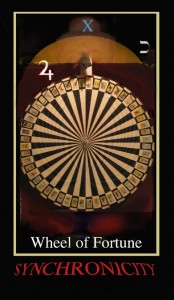 Even after reading and accepting (albeit provisionally) the foregoing discussion pertaining to the meeting of Psychology and Tarot, the responsible psychotherapist will still properly wonder: How could these spiritually-based, randomly-selected Tarot cards be reliable and valid in psychological treatment? It is one thing to establish a Tarot lexicon based on sound psychological principles, or even stunning metaphysical insights, but quite another to actually bring this arcane instrument into one’s livingroom, much less one’s consulting room. Particularly as the Tarot method requires placing supreme trust in the natural intelligence that collects around sacred or “empowered” randomness, many will feel hesitant, fearing the method’s lack of reliability. Before being sufficiently comfortable to introduce so unorthodox a tool into actual practice, the therapist will need to better understand the mysterious mechanism of its operation. How on earth, she well asks, does it work?
Even after reading and accepting (albeit provisionally) the foregoing discussion pertaining to the meeting of Psychology and Tarot, the responsible psychotherapist will still properly wonder: How could these spiritually-based, randomly-selected Tarot cards be reliable and valid in psychological treatment? It is one thing to establish a Tarot lexicon based on sound psychological principles, or even stunning metaphysical insights, but quite another to actually bring this arcane instrument into one’s livingroom, much less one’s consulting room. Particularly as the Tarot method requires placing supreme trust in the natural intelligence that collects around sacred or “empowered” randomness, many will feel hesitant, fearing the method’s lack of reliability. Before being sufficiently comfortable to introduce so unorthodox a tool into actual practice, the therapist will need to better understand the mysterious mechanism of its operation. How on earth, she well asks, does it work?
Little assurance will be drawn from so unlikely an apologist as Fred Gettings, occult author and compiler of the voluminous Fate & Prediction: An Historical Compendium of Palmistry, Astrology, and Tarot , who himself allows an echoing, if not disconcerting, sentiment: “Although the Tarot method works,” he writes, “it must be admitted from the outset that no one has ever been able to explain how it works [italics mine].”2 Perhaps a more precise summation of Mr. Gettings’ factually correct assertion would grant that although the mechanism behind Tarot has been speculated upon in multiple arcane and exotic ways, from nonlinear postulates of theoretical physics to ancient wisdom myths like Indra’s Net (and everything in between), still no one to date has empirically demonstrated to any satisfaction how or even “that” the Tarot method works.
To do so scientifically, one must clearly demonstrate a causal relationship linking method and effect, a linkage that can be repeated under similar conditions by different observers. The inherent problematics of scientific proof for a subjective, invisible, and irregular effect present a real challenge to the would-be Tarot empiricist, much as is encountered with related depth techniques or even in the fierce “brain versus mind” debates brewing in the emerging science of consciousness. It is widely agreed that scientific study is not well-equipped to penetrate the subjective dimensions of the human mind. The problem with classical scientific method when dealing with intrapsychic states is that mental events are not always clearly distinguished, nor are they independent from each other. Subjective effects in some cases are not easily translatable into precise language, nor are they consistently or objectively reported. There is no clear flowing of influence from one event to the next as (allegedly) with outer behavior, and finally, “psychological time” is neither linear nor unambiguous, but irregular, observer dependent, and contextually shaded. All of which makes direct quantification and measurement especially troublesome.
The Theory of Meaningful Chance
Such inherent difficulties notwithstanding, I believe an empirical explanation for the Tarot method can indeed be demonstrated in Jung’s theory of synchronicity. As we suggested earlier, many explorers today believe synchronicity carries the key not only to divinatory practices but to paranormal phenomena and certain anomalous physical phenomena as well. Herein lies a region we may refer to as “metascience,” the study of invisible, acausal, non-linear relationships between inner and outer worlds.
As was briefly discussed [in Chapter Four], the term “synchronicity” made its first introduction into the world’s lexicon in 1938 by Carl Jung, in his quite famous foreword to sinologist Richard Wilhelm’s classic translation of the I Ching. For those not familiar with the Book of Changes, it has been without rival the fundamental text of traditional Chinese culture and continues to capture the imagination of intuitively-inclined Westerners today. The text is a divinatory system with 3000 year old roots in the traditions of magic and shamanism. Nearly all that was significant in traditional China–philosophy, science, politics and popular culture–was founded on interpretations and adaptations of the I. The core of the book is considered the oldest and most complex divinatory system to survive into modern times.
Perhaps more than any other divinatory tool, the I Ching’s mechanism of operation parallels that of Tarot. The Chinese term I, reminiscent of our description of the Tarot method, emphasizes “imagination, openness and fluidity” as contemporaryI Ching scholars Ritsema and Stephen Karcher (1994) note:
“[I ] suggests the ability to change direction quickly and the use of a variety of imaginative stances to mirror the variety of being. The most adequate English translation of this isversatility, the ability to remain available to and be moved by the unforeseen demands of time, fate, and psyche.”3
The authors further summarize:
“The I Ching offers a way to see into difficult situations, particularly thoseemotionally charged ones where rational knowledge fails us yet we are called upon to decide and act…[It] is able to do this because it is an oracle. It is a particular kind of imaginative space set off for a dialogue with the gods or spirits, the creative basis of experience now called the unconscious. An oracle translates a problem or question brought to it into an image language like that of dreams. It changes the way you experience the situation in order to connect you with the inner forces that are shaping it. The oracle’s images dissolve what is blocking the connection, making the spirits available.”4
From highly personal divinatory experiments with the Chinese Book of Changes or I Ching, Jung advanced the synchronicity hypothesis. In his later works he more generally describes synchronicity in relation to certain strange curiosities of nature operating in various rare instances of inner/outer “crossovers” which defy normative constructions of reality. Such anomalies as prophetic dreams, unconnected parallel processes, paranormal oddities and chance occurrences in which subject and object mysteriously seem to collide are included in this brave literature of “acausal” connection. According to Jung, synchronicity is a special case of “acausality” that additionally produces in the observer some intimate, self-deepening, or spiritually-enhancing meaningfulness, or put in the Jungian vernacular, “unconscious compensation in the service of individuation.”
By this definition, not all acausal phenomena are necessarily synchronistic. As its name implies, ‘acausality’ simply means that no exchange of energy (the hallmark of Newtonian causality) is transmitted between related events. Examples have been shown, for instance, by experimenters like Robert Jahn et. al. at the Princeton Engineering Anomalies Research Laboratory (PEAR) that certain acausal phenomena occurs naturally and can be scientifically demonstrated as such. Through studying the interaction of human consciousness and complex machines (“sensitive physical devices, systems, and processes common to engineering practice”) Jahn has shown that a test-subject’s conscious intent could influence a machine’s operation. Such effects, though usually quite small, have nevertheless been proved to be statistically repeatable and appear to be operator-specific in their details.5
Technically however, these extraordinary findings of ‘acausal connection’ are not purely ‘synchronistic’ as they carry no particular meaningfulness to the subject unless, of course, the test-subject is lucky enough to be a race car driver, a machine-gun mercenary, or even a high-speed computer user with minimal techno-skills like myself, in which case, any clairvoyant repartee with one’s machinery would prove immensely meaningful indeed. Be that as it may, one point is certain as put succinctly by Jungian author James A. Hall: “Science without parapsychology is two-dimensional. Parapsychology without synchronicity misses psyche.”6
Therapists in all their sophistication should take heart as they search for alternative explanations for the “synchronicity hypothesis.” Jung stipulates clearly that acausality requires not merely the absence of physical energy exchange between events, but equally the absence of psychological energy exchange as well. Victor Mansfield (1995) an astrophysicist and synchronicity author, further specifies this point: “just as gravity causes the apple to fall, anxiety causes the head to shake.” Both events are easily explained by ordinary causation. Psychological causation (like physical causation) contradicts the elusive precondition of acausality itself; Jung carefully stressed that neither repressed contents, defense mechanisms, complexes, nor archetypal constellations could cause such coincidences, thereby ruling out subtler mechanisms like projective identification or conversion from slipping through the psychological cracks.7
Synchronicity And Events
Examples of synchronistic phenomena are easily illustrated in collective events, as for instance, the Oklahoma City Bombing of April 19, 1995. But first, let’s examine (hypothetically) the more likely cause-and-effect scenario of this incident, which must be ruled out should we find the genuine article. Suppose several research psychologists attempted dream studies in Oklahoma City following the event. They discover significant numbers of subjects reporting dreams and fantasies involving sabotage and destruction, of buildings exploding, of hidden bombs or mass death–that is, dreams occurring shortly after reports of the tragedy. These parallels would hardly be considered ‘synchronistic’ or even ‘acausally-connected’. The psyche of such dreamers has obviously been affected by psychological causes churning throughout local and collective awareness. Anxiety dreams following shocking events of this nature are quite common. To the contrary, after the tragic news one might rather expect a great many people in all parts of the country to incorporate this upsetting imagery in their dreams. We would then obviously rule out ‘synchronicity’ to explain such clearly ‘caused’ correspondences.
If, on the other hand, a particular dreamer reports: (1) the same sort of mayhem and destruction in his dream, perhaps with lucid details of the Ryder truck, the screaming panicked government employees, The Murray Building collapsing etc.; (2) this startling dream occurred on the night preceding the catastrophe; and (3) we can be certain this dreamer bears no possible conscious or unconscious relationship to the conspirators themselves, or has not been made privy at all to their goings on whatsoever; then, (4) it is then safe to conclude that those clamoring headlines discovered on the morning AFTER the event (by said dreamer) must reasonably be considered ‘acausally-connected’ to the dream. This is simply because the actual event for which such dream content was referent had not yet taken place.
No exchange of energy can therefore connect these two events or account for their mutual co-arising, neither physical nor mental energy. An acausal connection is thus clearly established between dream and event. But note: “synchronicity” has not yet technically occurred. If then, (5) upon reading the dreadful report in the newspaper on the morning after, the dreamer is thus struck meaningfully (i.e. in regards to his/her own sense of psychospiritual purpose or individuation) by this eerie coincidence, and encouraged perhaps to reevaluate core beliefs (say, of the importance of family, or perhaps, the impermanence of life and death) owing to this strange coincidence, it is at that point, officially, that these two events have produced a bone fide “synchronicity.” They are now, in Jung’s famous phrase, “acausally connected through meaning.”
Of course, the parapsychologist may beg to differ. His argument would insist that a causal exchange did in fact occur: the dreamer was simply prescient, his psychic foreknowledge (precognition) would account for (i.e. caused) the seeming dream coincidence as such. It was simply a case of prescience or clairvoyance; in a manner of speaking, the ‘future’ had caused the dream! It’s simply that we have not yet the technology to measure such invisible forces. Jung himself, with his great fascination for J.B. Rhine’s groundbreaking ESP experiments at Duke in the 1930’s, entertained the impressive parapsychological evidence contributing to synchronistic phenomena. Many in the Tarot community, as well, believe divination to be a psychic phenomenon, with the cards acting as “psychic springboards” or triggers for telepathic, clairvoyant, or precognitive phenomena. Paranormal research, in fact, may one day isolate certain subtle and causal energy fields operating between Tarot cards, readers and subjects, and require major revisions of the synchronicity hypothesis.
More recently, however, Mansfield (1995) challenges this argument by making a compelling case against such paranormal attributions which, in effect, violate the technical specifics of Jung’s own treatise.3 Psychic causes, Mansfield contends, suggest some transfer of energy between bodies, albeit to date, not an “energy” clearly isolated, measured, or demonstrated as such. Psychic causal agents, of course, even unseen hypothetical ones, would veer away from Jung’s central notion of “acausality.”
Absolute Knowledge
Suggested in Jung’s theory of synchronicity is the presence of some underlying interior intelligence at work, some non-personal agency of wisdom which purposively guides each individual psyche towards its predestined objectives of balance and wholeness (equilibrium and individuation). Empty of the sentiment that normally muddies human perception, this higher logic flows more like a fresh running river. It is deep and clear, cool and nonpersonal, unfixed and nonlocalized. Though accessed from a mysterious source, it is nonetheless closer to the natural order. It is immune to those arbitrary habits or conventional thinking which, in the final analysis, may rest on no logic at all.
For Jung, such transcendent intelligence is viewed as the very matrix from which all psychological development and transformation unfolds; it operates through a system of compensatory self-regulations for the purpose of linking conscious and unconscious worlds with the objective of psychological wholeness. This view is quite distinct from the determinist constructions of evolutionary psychology which place more emphasis on the role of social and cognitive factors of adaptability without reference to teleology.
From a depth psychological perspective, the bridge that this transcendent intelligence uses to link conscious and unconscious worlds is the symbol. After all, one might pause to consider this: given the generally accepted hypothesis that dreams and dream symbols are significant and meaningful, and moreover, that these spontaneous unconscious narratives are revealing, multifaceted, intricately crafted, economical, restorative, poetic, and even comical– then by whose masterful intelligence are they authored? The sleeping child? Your snoring, comatose “creative side?” Who is it really, in the final analysis, that speaks to us when we sleep? After studying thousands of such dreamscapes captured from his patients and his own mind, Jung was moved to formulate the concept of “absolute knowledge” to account for their true creator:
“Final causes, twist them how we will, postulate a foreknowledge of some kind. It is certainly not a knowledge that could be connected with the ego, and hence not a conscious knowledge as know it, but rather a self-subsistent “unconscious” knowledge which I would prefer to call “absolute knowledge.” 8
Habitual Causality
One needn’t be a behavioral psychologist to know that old habits die hard. These learned patterns of activity through chronic repetition become automated, fixed, and effortlessly carried out much like putting one’s left sock on first each morning. As author Umberto Eco laments
“I believe that you can reach the point where there is no longer any difference between developing the habit of pretending to believe and developing the habit of believing.”
Given the undeniable fact of our own nearly intractable, causally pre-conditioned, modern habits of explanation– the cognitive reflex that needs to discern “this is so because of______,” I think it is safe to surmise that many reading this brief synopsis of the synchronicity hypothesis, and even Tarot divination in general, will find it bordering on the ungraspable. I myself feel this way often. There will likely be a gnawing urge to restate the obvious, at least to oneself, as almost everything learned throughout our scientifically-constructed lives has taught us not to presume otherwise. Be it parlor trick, clairvoyant reader, psychological illusion, misattribution, projective identification, accident, meaningless coincidence, miracle, or loaded deck: something surely must be given credit (or blame) as the “real cause.”
Jung’s puffy phrase “absolute knowledge,” a cause without a cause, will smack of fuzzy theology and leave the scientifically-grounded and metaphysically-squeamish (i.e. most therapists) whining about Ouji boards. His or her gut will continue to encourage rational assurances: “There can be no reliable effects resulting from non-existent or indiscernible causes.” Of course, the corollary to this logic is equally tenacious: “if no reliable cause can be established, then the effects of the reading cannot be valid.” A short while later, after the Tarot reading one has just witnessed does appear to be unambiguously accurate, “amazing” by some accounts, or at least, strikingly meaningful to its subject, then and there, as a matter of habitual reflex, the explanatory litany of accidental factors, suggestibility, projection, fraud, or “coincidence” is causally assigned. We are relieved. Phew… “It was merely an instance of _________.”
But no matter. In defiance of our reassuring rationality, the synchronistic hypothesis reasserts its ugly head: All energetic exchanges between reader/querent/card are categorically ruled-out and unrelated to the effect! That is, no parlor trick, no clairvoyant reader, no psychological illusion, no misattribution, no projective identification, no accident, no meaningless coincidence, no miracle, and no loaded deck has caused the reading’s accuracy. Indeed, there are NO BECAUSES.
To the contrary, one finds instead only the disquieting reminder that the world moves in mysterious ways. Meaning has arrived acausally as a function of the method itself, involving no extrinsic influence whatsoever. Instead, an agent presumably of ‘higher intelligence’ or ‘absolute knowledge’ (at least from our limited vantage points) has delivered the correct cards for this moment much as it delivered the correct dream in all its well crafted complexity last night. Although in Tarot, unlike the dream, the agent is deliberately called forth. Sagaciously, and in concert with the emotional motivation of the querent, the Tarot method itself creates conditions for the probability of synchronicity to occur. And as mentioned in a previous chapter, psychologists will likely locate this innate, guiding agency as residing within the psyche, while metaphysicians, theologians, and perhaps quantum physicists will place its residence in nature or in god.
In the Tarot method, a procedure that intentionally disrupts and confounds linear assumptions, the meaningful coincidence that occurs between cards and querent can not be causally explained, because in the final analysis, there is no conventional causality operating. A linkage between mind and matter, subject and object, has been facilitated by what has been deemed ‘empowered randomness,’ the vehicle of oracularly-intended synchronicity. This phenomenon is likely to be simply an occurrence of nature– related perhaps to “The Force” (of Star Wars fame)–though typically unrecognized due to our vast inculcation of scientific realism and habitual causality. When it occurs spontaneously we deem either fraudulent or else categorize it as “some religious miracle.” Such describes the so-called “apex problem” of the Tarot practitioner, mentioned earlier with Thought Field Therapy.
We should regard such things in keeping with our earlier theme of opposition: that is, so-called ‘acausal/synchronistic’ phenomena are merely the other side of conventional causality, “like the different, but inseparable, sides of a coin, the poles of a magnet, or pulse and interval in any vibration (Watts).”
The apparent rarity of synchronistic occurrences reflects more than anything our habit of causal explanation. If we can’t explain it, it probably doesn’t exist. But it is important to remember that the concept of so-called “randomness” is itself a modern invention that developed out of the dogma of causation. Of course, that well-oiled band of naysayers–the professional skeptics and debunkers–who bravely embrace the scientific realism of the 19th century, will not be deterred by such unbridled “metaphysical hogwash” but instead will salivate over such claims like greedy jackals over wounded rabbits. “Blatantly unscientific!” they hoot and snarl with great assurance. “Prove it! Prove it! The method is flawed, it’s entirely random. It can never be re-peat-ed!”
Little do these smug evaluators realize that Tarot’s random selection is precisely what makes it Tarot. Repeatability is hardly the point. Like each unique fingerprint or signature of human identity, no two Tarot readings are ever identical or repeatable per se. Though what does repeat, should we call it that, is the consistent and striking experience of meaning for the subject. John Van Eenwyk notes in Archetypes & Strange Attractors: The Chaotic World of Symbols (1997):
“If a dynamic repeats over and over (orbits, chemical reactions, symbols), it is possible eventually to figure it out. That which occurs just once, however (miracles, the creation of the universe, a crank telephone call) is infinitely more difficult to decipher. Repetition creates patterns that can be scrutinized. Single occurrences are incomparable, hence they tend to be labeled “random.”9
The serious scientist, without the professional skeptic’s need to prejudge or “debunk” to make his living, does, however, indeed hold forth a legitimate challenge for objective verification. To my mind, solid scientific verification of the synchronicity hypothesis is an unrivaled and highly worthy challenge for the very best scientific explorers. But as the imaginative, and indeed highly regarded scientific thinker Arthur C. Clarke recently noted from his home in Sri Lanka:
“We need more scientists…to push the limits of knowledge and understanding. Science, unlike politics or diplomacy, does not depend on consensus or expediency– it progresses by open-minded probing, rigorous questioning, independent thought and, when the need arises, being bold enough to say that the emperor has no clothes.”10
In this case is the Emperor clothed or naked? The scientist is quite right to wonder: Could this synchronistic hypothesis using the Tarot method be demonstrated experimentally? Could it empirically be shown to have practical value and application? Regardless of Tarot’s inherent difficulties with scientific measurement, could a pilot study of sorts be designed to demonstrate sufficient consideration of this approach, in the least to initiate a path of further research and experimentation? The following chapter describes one of several such pilot studies conducted by the author wherein the synchronicity hypothesis was tested.
Notes
1 Jung, C. G., ‘On the Nature of the Psyche’. Reprinted in Collected Works Vol. 8; Second edition (Princeton University Press), Ziff, 246, p. 167.
2 Getting, F., Fate & Prediction: An Historical Compendium of Palmistry, Astrology, and Tarot; Exeter, New York, 1980, p. 157.
3 Ritsema, Rudolf, and Karcher, Stephen [trans] I Ching: The Classic Chinese Oracle of Change; Element Books Limited, Great Britain, 1994, p. 10.
4 Ibid.
5 Jahn, Robert, and Dunne, Brenda, Margins of Reality: The Role of Consciousness in the Physical World; Harcourt, Brace, Javanovich, New York, 1987.
6 personal correspondence, 1998.
7 Mansfield, Victor, Synchronicity, Science, and Soul-Making, Open Court. 1995, pp. 22-36.
8 Jung, C. G., Synchronicity [Collected Works, Vol. 8]; Princeton University Press, Princeton, N.J., 1978, p.493 ”
9 Van Eenwyk, John, Archetypes & Strange Attractors: The Chaotic World of Symbols; Inner City Books, Toronto, Canada, 1997, p. 42.
10 Clarke, Arthur, C. quoted in The San Diego Union Tribune [“La Jolla Nobelist rocks the scientific boat”, Graham, David, E.), September 15, 1998, p. A13.
Readers– Chapter 9 actually introduces the final section of my book, The Tarot Research Project, which is a landmark pilot study of the synchronicity hypothesis; unlike anything attempted before, it explores tarot divination with an experimental population of spousal abusers and female victims (that I conducted in 1997 in Southern California). If interested, order directly on Amazon.com or from Paragon House. FSA
Share this:
-Meditation or Medication? (Article)
Trying to heal your depression with spiritual practice alone can make the condition chronic and prone to relapse, says a new study. Physicians and long-term meditators Roger Walsh, Robin Bitner, Bruce Victor, and Lorena Hillman explain why both antidepressants and meditation have an important role to play in treating depression.
When we first set foot on the spiritual path, many of us believed that spiritual practice was all we needed. Ancient texts spellbound us with stories along the lines of, “They heard the teaching, retired into the forest to meditate, and awoke.” End of story! How simple and easy. But somewhere along the path we ran into a problem—reality. It became glaringly apparent that many classic accounts of spiritual life were extremely idealistic, similar to the Hollywood sagas of boy meets girl, where boy and girl fall in love, ride off into the sunset, and live happily ever after. Anyone in an intimate relationship knows that something has been left out of the story.
In short, spiritual practice turned out to be far more complex and demanding than advertised. True, there were many gifts and graces, and some awe-inspiring glimpses of our spiritual potentials along the way. But covering up these potentials were often layer upon layer of difficult emotions, compulsive conditioning, and countless old wounds, fears, and phobias. And ironically, spiritual practice frequently makes these challenges more painfully obvious.
Clearly we had taken on a big project, and our initial fantasies of doing a few retreats, and thereafter basking in unalloyed bliss, quickly faded as a more realistic appreciation of the path dawned. The enormous challenge of healing and awakening one mind—let alone all minds as per the bodhisattva vow—became dauntingly apparent. Some of us even began to wonder if spiritual practice by itself was always adequate to the task.
As a result, many of us who have practiced meditation and undertaken a spiritual path for an extended period have questioned whether there are other methods we can draw upon in trying to optimize our individual and collective healing and awakening—methods that don’t come from the spiritual traditions themselves. And as the number of spiritual, psychological, medical, and other healing practices continues to multiply, this becomes an increasingly perplexing—and ever-more relevant—question. We need a significant and disciplined evaluation of how best to combine dharma and diverse therapeutic disciplines, including the most controversial of all therapies: medication.
In fact, such an evaluation has already begun. It’s in its early stages, but it is indeed underway.
Psychotherapy and Meditation
When Buddhism first came to the West, many teachers and practitioners initially dismissed psychotherapy as superficial, unnecessary, and possibly counterproductive. As time went on, more and more students faced crises or simply felt their spiritual practice was not dealing with deeper problems that were hindering their development. Psychotherapy’s relationship to spiritual practice started to undergo a reevaluation, and the two disciplines began to intermingle a bit more. Among the first to bridge the divide between therapy and spiritual practice was Jack Kornfield, who is both a meditation teacher and psychologist. In 1993, he wrote an article called “Even the Best Meditators Have Old Wounds to Heal: Combining Meditation and Psychotherapy,” which was published in the book Paths Beyond Ego: The Transpersonal Vision. In it he argued:
For most people, meditation practice doesn’t “do it all.” At best, it’s one important piece of a complex path of opening and awakening….There are many areas of growth (grief and other unfinished business, communication and maturing of relationships, sexuality and intimacy, career and work issues, certain fears and phobias, early wounds, and more) where good Western therapy is on the whole much quicker and more successful than meditation….Does this mean we should trade meditation for psychotherapy? Not at all….What is required is the courage to face the totality of what arises. Only then can we find the deep healing we seek—for ourselves and for our planet.
Controversial in their time, Kornfield’s ideas have now gained wide acceptance. In fact, meditation and psychotherapy are being integrated in many different contexts, as therapy clients and patients are offered meditation and meditators are offered therapy. Research has convinced therapists of the value of meditation for a host of psychological and psychosomatic difficulties. In fact, many therapists and meditation teachers now agree that meditation and psychotherapy can be mutually facilitating. Meditators seem to progress more quickly in therapy, while psychotherapy can improve the effectiveness of their meditation.
In addition, combination therapies that integrate meditation and psychotherapy are proliferating, and often prove more effective than either application alone. The original inspiration was Jon Kabat-Zinn’s widely used “mindfulness-based stress reduction” (MBSR). Originally designed to treat chronic pain, MBSR has since proved helpful with a diverse array of psychological and psychosomatic difficulties. Examples of disorders that have responded well to MBSR range from anxiety, aggression, stress, and eating disorders on the psychological side to asthma, angina, and high blood pressure on the somatic side.
Several recent combinations merge Buddhist mindfulness with specific psychotherapies. These include, for example, “mindfulness-based cognitive therapy” for depression, “mindfulness-based sleep management” for insomnia, and “mindfulness-based relationship therapy” for enhancing relationships. Research affirms the effectiveness of each of these approaches. More broad-based combination treatments—such as transpersonal and integral therapies—incorporate multiple psychological, spiritual, and somatic strategies. In short, the integration of contemplative and conventional therapies is proceeding rapidly, and the results are promising.
Combining meditation and psychotherapy makes sense if we appreciate how they work in complementary ways. For the most part, meditation focuses primarily on developing capacities such as concentration and awareness, whereas psychotherapy focuses primarily on changing the objects of awareness, such as emotions and beliefs. Of course, there are also significant overlaps, but this complementarity suggests why combining both approaches can be very helpful. Meditative qualities can facilitate psychotherapeutic healing of painful patterns, while the psychotherapeutic healing of these painful patterns can reduce their disruption of spiritual practice.
What are the practical implications of this conjunction of psychotherapy and spiritual practice? It seems clear that the question of whether meditation and psychotherapy can enhance one another has been decided: many people benefit from combining them, and this has been observed by clinicians and demonstrated by research. When old traumas, pains, and patterns recycle endlessly, or make spiritual practice seem overwhelming and hopeless, the best answer may not be simply the classic one of more practice. Instead, psychotherapy may be called for.
Medication and Meditation
Sometimes neither meditation nor psychotherapy—nor even the combination of the two—is enough. Depression can be so debilitating, anxiety so agitating, and old pains so traumatic that spiritual practice withers and psychotherapy has little effect. Mental approaches alone prove insufficient. And this brings us to one of the most hotly debated topics among spiritual practitioners: the appropriateness of using medication to help with psychological and spiritual difficulties. Two groups have staked out polar positions. We could call them the purists and the pragmatists.
Spiritual purists argue that if mental suffering is fundamentally spiritual and karmic, spiritual practice alone is appropriate to treat it. A standard response to difficulties is therefore “more practice.” Moreover, they are concerned that medication may dull or derail spiritual practice. They worry that if suffering is merely dissolved with a pill, the motivation to practice may dissolve with it. They also worry that medications may reduce or distort awareness, and thereby make practice more difficult. In this view, medications such as antidepressant or antianxiety agents can be novel forms of the “mind-clouding intoxicants” prohibited by the lay precepts to which many Buddhist practitioners adhere. Therefore, taking these modern pharmacological agents is tantamount to violating this precept. Another worry is that potentially valuable spiritual challenges such as the classic “dark night of the soul” may be misdiagnosed as psychopathology, and then be suppressed with drugs rather than explored and mined.
By contrast, pragmatists hold that spiritual practice alone is simply insufficient, or at least not optimal, for healing all mental suffering. While not denying the validity of some purist concerns, pragmatists argue that certain problems and pathologies respond best to other therapies, and one of these therapies can be medication. Stan and Christina Grof—who have written extensively about spiritual emergencies and founded the Spiritual Emergence Network to offer support to people who find themselves in such emergencies—encourage this pragmatic perspective. They certainly agree that some spiritual emergencies are best treated not with medical suppression, but with time-honored spiritual and psychological principles. These principles include providing a supportive relationship with a spiritual guide, reframing (where appropriate) the emergency as a spiritual process and opportunity, and setting positive expectations. However, they also recognize that some emergencies are so overwhelming that they require medical intervention.
As for the idea that there is something inherently unspiritual about taking drugs to modify neurotransmitters such as serotonin, we might consider how John Tarrant Roshi, who is also a Ph.D. psychologist, demystifies the brain’s chemistry. “What is serotonin?” he asks. “It, too, is a piece of the original light. For some people it comes in the form of serotonin; for others in the form of a smile. There is more than one way to move neurotransmitters around—meditation can do it; having someone hug you does it, too.”
The purist-pragmatist debate is curiously reminiscent of one that rocked psychiatry decades ago. At that time, the psychiatric world was ruled by psychoanalysts who believed that virtually all psychological problems and pathologies could be traced to earlier psychological causes. They threw up their hands in horror when antidepressants and antipsychotic medications first appeared, claiming that the drugs merely relieved surface symptoms, while leaving the deeper causes untouched. Eventually they changed their minds as pharmacological successes multiplied, and especially when some long-analyzed but little-helped patients responded well to antidepressants, and subsequently sued their psychoanalysts for having withheld medication. It’s not that psychoanalysis is useless, but rather that by itself, it may be insufficient to treat severe psychological disorders. Likewise, meditation and spiritual practice may also be insufficient by themselves to address severe psychological difficulties.
The Hell Realm of Depression
The question of effective treatment is a crucial one, because the cost of inadequately treated mental disorders is extraordinary. For example, major depression ranks as the world’s fourth leading medical cause of disability, and for poorly understood reasons, its frequency and severity seem to be increasing. Yet most people with depression, including those who are spiritual practitioners, go untreated. This is a tragedy, because the suffering and debilitation of major depression can be horrific and heart-rending for all those who are touched by it. Consider the following statements from depression sufferers:
I accidentally tripped over my cocktail table, breaking both of my legs. I want you to know that the pain that I experience from depression is so much worse than the pain associated with my breaking both my legs.
The psychological pain I felt during my depressed periods was horrible and more severe than my current physical pain associated with metastases in my bones from cancer.
Hearing these expressions of pain coming from the depths of people’s being reminds us that depression has been regarded as a spiritual crisis in some traditions, despite that fact that classical Buddhism makes little mention of it. For example, the noted Jewish Kabbalist, Aryeh Kaplan, was very explicit: “There is nothing that can prevent enlightenment more than depression, even for those who are worthy.”
Most people today know someone who has been affected by depression, and therefore understand how severe and disabling depressive suffering can be. And for some time now, we have been hearing accounts about the relief that antidepressants can offer to those who have been struck with it. Buddhist practitioner Sheva Carr long resisted taking medication, but after doing so, wrote movingly:
Do you know what it is like
to be so sensitive
that the air makes your eyes
sore and so does sleep?….
To be so sensitive
that food forges flaming
fireworks in your gut?….
What is it like to go on
antidepressant medication?….
It is what it is like to be drowning daily
and then suddenly find yourself floating
face up to the sun.
In spite of a growing body of research evidence indicating the effectiveness of medication, and anecdotal accounts of its benefits for meditators, there has been much debate in spiritual circles about the use of medication. What has been lacking, however, is actual research and data on spiritual practitioners themselves. So we and others have begun to undertake such research, and early findings indicate that when it comes to the use of medication by meditators, the evidence is lining up on the side of pragmatism.
Brain and Mind
Let’s look first at the relationship between mental states and brain states. We all know that changing the state of the brain—such as by hunger, a cup of coffee, or a tranquilizer—can have dramatic effects on mental states. What new technologies such as brain scans reveal is that the causal relationship can run in the other direction: mental states also affect brain states. A wide array of stimuli and situations—from exercise and out-of-the-ordinary experiences to meditation and psychotherapy—can actually alter both the structure and function of the brain. (For an excellent summary of what researchers have been learning about neuroplasticity, meaning how brain structure and function is able to be modified, see the book Train Your Mind: Change Your Brain, by Sharon Begley.)
It is therefore not surprising that meditation and psychotherapy can improve some neural functions, and sometimes partly heal the chemistry and even structure of the brain. Consequently, we can certainly expect that some brain–mind dysfunctions will be healed, or at least ameliorated, by spiritual and psychological interventions.
But other dysfunctions may prove recalcitrant. Major chronic disorders—whether the result of faulty genes, horrendous child rearing, or long-term stress—may be so severe and so indelibly stamped into neural chemistry and architecture that almost no amount of meditation or psychotherapy will fully reverse or override them. In such cases the most strategic way to redress both symptoms and the underlying neural pathology may be by direct neural interventions, which most commonly take the form of rebalancing neural chemistry via medication.
Again, this is not to say that spiritual practice or psychotherapy won’t help, but rather that, by themselves, they may be insufficient. Even very long-term practice may be insufficient. In fact, we have seen and consulted with not only practitioners, but also several teachers whose long, dedicated practice was simply not enough to fully override genetic forces and major traumas, and who benefited from medication. Optimal healing may require multiple therapies, one of which is pharmacotherapy.
This is easy to say, but it can still be a hard decision for spiritual practitioners wrestling with the question of whether to begin taking medications, most commonly, antidepressants. This is where research on how spiritual practitioners have fared when taking medication could offer helpful information to those trying to make this difficult decision, particularly if they face the pressure of the purist point of view.
Buddhist Practitioners Who Took Antidepressants
Our team of researchers, all physicians and long-term meditators, investigated a group of nineteen Buddhist practitioners (thirteen women and six men) diagnosed with major depression. These practitioners had all been doing meditation, mainly vipassana, for at least three years, had participated in two or more weeklong retreats, and had used antidepressants in the last two years. By far the most commonly used medications were selective serotonin reuptake inhibitors (SSRIs)—such as Prozac, Zoloft, and Celexa—which as the name indicates specifically inhibit the reuptake of the mood-regulating neurotransmitter serotonin.
We asked these practitioners for detailed reports on their experiences while taking antidepressants, both in daily life and on retreat. We wanted to find out not only if the antidepressants seemed to help, but exactly how they helped, and what effects they had on mind, meditation, and daily life.
The effects proved powerful and positive. Most of our subjects reported that antidepressants helped them with multiple emotional, motivational, and cognitive functions. Emotional changes were consistent with an antidepressant effect. The painful emotions of anger and sadness decreased significantly, but fear showed a smaller response. The positive emotions of happiness, joy, love, and compassion all increased, as did self-esteem.
Motivation underwent an intriguing shift. Depression is often accompanied by a dispirited lack of motivation and interest, so it is significant that our subjects felt more motivated. Yet at the same time they reported that attachments or craving actually diminished. Clearly, they were reporting a motivational shift in a healthy direction. Subjects also felt calmer and that their awareness was clearer. One would expect this kind of result, given that the subjects were no longer wrestling with intense, painful emotions.
Two benefits we had anticipated were not clearly displayed by the participants. During depressive episodes, people often complain of low energy and poor concentration. Consequently, we expected that successful antidepressant treatment would improve energy and concentration. However, while there was a trend in this direction, it did not reach statistically significant levels.
The largest effect of all was a dramatic increase in equanimity. Equanimity is the capacity to experience provocative stimuli fully and nondefensively, without psychological disturbance. It is highly valued across contemplative disciplines, and has been described as “divine apathea” by the Christian Desert Fathers, “euthymia” by Stoics, “dispassion” by yogis, and “serenity” by Hassidic Jews. In Buddhism, equanimity is one of the seven factors of enlightenment (seven mental qualities that are particularly vital for spiritual maturation) and the last of the four immeasurables, or four divine abodes, of loving kindness, compassion, empathic joy, and equanimity.
What We Have Learned
What do these findings suggest? Clearly, the large majority of these meditators felt that they, and their spiritual practice, benefited significantly from taking antidepressants. The changes they described bear this out. In fact, whether looked at from either a classical contemplative or a contemporary psychological perspective, the multiple benefits they describe suggest greater psychological and spiritual well-being.
Several subjects reported that the antidepressants enabled them to recommence or significantly improve their meditation and spiritual practice. In addition, two subjects spontaneously reported that antidepressants gave them a lift that they were subsequently able to maintain with meditation alone. This observation that meditation may maintain gains initially obtained with medication is particularly important because it is now painfully apparent that major depression can be a long-term, relapsing condition, especially if left untreated. In fact, the longer major depression goes untreated, the more likely it is to become chronic, to relapse, and to become resistant to treatment. Early effective treatment and relapse prevention are crucial.
But how to prevent relapses is the challenge. Most physicians—and therefore their patients—now rely on long-term pharmacotherapy alone, even though once medication has alleviated the initial crisis, psychotherapy is sometimes more effective in preventing relapse. A similar pattern is emerging for other psychological disorders, such as panic disorder and obsessive–compulsive disorder. Here, too, initial medication can be helpful or even essential, but psychotherapy is sometimes more effective for maintenance. Certainly some people continue to require medication to prevent relapse. But psychotherapy helps others to maintain their health after eventually stopping the medication.
It seems likely, then, that meditation and other spiritual practice—especially daily, long-term practice—might also help to prevent relapse and maintain health. In fact, the combination of meditation and cognitive therapy in mindfulness-based cognitive therapy has already proven particularly helpful in preventing relapse back into depression.
Limitations of Antidepressants
Of course, antidepressants are not panaceas. They do not work well for everyone and, like all drugs, can have side effects. Unfortunately, they are often the only treatment offered by some physicians, and the only one medical insurance will pay for, even though they work best when carefully titrated by a psychiatrist and combined with other approaches.
An optimal combination might include antidepressants, psychotherapy, spiritual practice, and a healthy lifestyle. Such a lifestyle would certainly incorporate exercise, which can be very helpful for anxiety, depression, and many other psychological ills, especially those that are stress-related. Other essential lifestyle ingredients include social and spiritual support, time spent in nature, body work, and a good diet. In fact, dietary fish-oil supplements can be very helpful with depression, and possibly a wide range of other mental (and physical) health disorders as well.
Are there “spiritual side effects” or complications from antidepressant use? Our study did not detect any. However, this was a small study, and larger ones may well detect subtle spiritual costs, and perhaps more subtle benefits as well. Some practitioners, not in our study, complained of problems that could be termed spiritual side effects, particularly of being distanced from their feelings. In fact, one of us, Roger Walsh, discovered something similar when he was given the SSRI Zoloft to treat a gastric disorder (antidepressants have many uses in addition to treating depression). Though no side effects emerged while doing vipassana, during a metta retreat he found that the drug inhibited the powerful positive emotions of happiness, joy, and love usually elicited by this practice. In fact, his observation provided the original motivation for doing our research. There may well be other subtle spiritual and psychological side effects from antidepressants (and other medications) that have yet to be identified.
This simply confirms the classic wisdom that all treatments—medical, psychological, and spiritual—can have side effects and unexpected complications. There are no free therapeutic lunches; all treatment decisions involve weighing costs and benefits. However, it is crucial to realize that it can be far more costly not to treat a disorder than to treat it.
Our small study, combined with other research, clinical observation, and patient reports, seems to indicate that many spiritual practitioners suffering from depression can benefit both spiritually and psychologically from the appropriate use of antidepressants. More generally, spiritual practitioners suffering from a variety of psychological disorders may benefit from judicious use of multiple therapies, including psychotherapy and medication. Trying to tough it out and heal oneself with spiritual practice alone may not only prolong unnecessary suffering, but also lead to greater risk of relapse, chronicity, and complications.
Being willing to face the unavoidable pains of life is often a sign of courage and wisdom. Nonetheless, being unwilling to use effective therapies to relieve unnecessary pains may be a sign of misunderstanding, and of a spiritual superego run amuck. After all, Buddhist psychology regards happiness and joy as healthy, beneficial, spiritual qualities, and discourages subjecting oneself to unnecessary pain as a spiritual path.
What we and our troubled world need is to carefully assess and optimally use the unprecedented array of therapies now available to us. Only such an open-minded, multipronged approach can hope to address the many sources of suffering, and thereby optimize healing and awakening for us and our world.
ROGER WALSH is professor of psychiatry at the University of California at Irvine, as well as author of Essential Spirituality: The Seven Central Practices and The World of Shamanism, and coeditor of Higher Wisdom: Eminent Elders Explore the Continuing Impact of Psychedelics.
ROBIN BITNER and BRUCE VICTOR are both in the Psychiatry department at the University of California at San Francisco, and Victor is also in private practice in San Francisco.
LORENA HILLMAN is a family practice physician in the San Francisco Bay Area.
The authors would like to thank the practitioners who volunteered to be subjects for the research described
Reprinted
©2002-10 Buddhadharma: The Practitioner’s Quarterly | Last modified: 12-AUG-10.
-Entelechy: Acorn To Oak
Relevant notes on Entelechy (Click)–the Aristotelian principle of “Endings within Beginnings” and the guiding principle behind Rosengarten’s Tarot of the Nine Paths (See “The Hermit Effect”).
-TNP: The Official Site of
View Rosengarten’s Tarot of the Nine Paths: Advanced Tarot for the Spiritual Traveler (Paragon House, 2009) including the Complete Travel Guide (click)
-Stirring the Oatmeal (Relationships)
By Robert Johnson
 Many years ago a wise friend gave me a name for human love. She called it “stirring-the-oatmeal” love. She was right: Within this phrase, if we will humble ourselves enough to look, is the very essence of what human love is, and it shows us the principal differences between human love and romance.
Many years ago a wise friend gave me a name for human love. She called it “stirring-the-oatmeal” love. She was right: Within this phrase, if we will humble ourselves enough to look, is the very essence of what human love is, and it shows us the principal differences between human love and romance.
Stirring the oatmeal is a humble act—not exciting or thrilling. But it symbolizes a relatedness that brings love down to earth. It represents a willingness to share ordinary human life, to find meaning in the simple, unromantic tasks; earning a living, living within a budget, putting out the garbage, feeding the baby in the middle of the night. To “stir the oatmeal”; means to find the relatedness, the value, even the beauty in simple and ordinary things, not to eternally demand a cosmic drama, an entertainment, or an extraordinary intensity in everything. Like the rice hulling of the Zen monks, the spinning wheel of Gandhi, the tent making of Saint Paul, it represents the discovery of the sacred in the midst of the humble and ordinary.
Jung once said that feeling is a matter of the small. And in human love, we can see that it is true. The real relatedness between two people is experienced in the small tasks they do together: the quiet conversation when the day’s upheavals are at rest, the soft word of understanding, the daily companionship, the encouragent offered in a diffuclt moment, the small figt when least expected, the spontaneous gesture of love. 
When a couple are genuinely related to each other, they are willing to enter the whole spectrum of human life together. They transform even the unexciting, difficult, and mundane things into a joyful and fulfilling component of life. By contrast, romantic love can only last so long as a couple are “high” on one another, so long as the money lasts and the entertainments are exciting. “Stirring the oatmeal” means that two people take their love off the airy level of exciting fantasy and convert it into earthy, practical immediacy.
Love is content to do many things that ego is bored with. Love is willing to work with the other person’s moods and unreasonableness. Love is willing to fix breakfast and balance the checkbook. Love is willing to do these “oatmeal” things of life because it is related to a person, not a projection.
Human love sees another person as an individual and makes an individualized relationship to him or her. Romantic love sees the other person only as a role player in the drama.
A man’s human love desires that a woman become a complete and independent person and encourages her to be herself. Romantic love only affirms what he would like her to be, so that she could be identical to anima. So long as romance rules a man, he affirms a woman only insofar as she is willing to change, so that she may reflect his projected ideal. Romance is never happy with the other person just as he or she is.
Human love necessarily includes friendship: friendship within relationship, within marriage, between husband and wife. When a man and a woman are truly friends, they know each other’s difficult points and weaknesses, but they are not inclined to stand in judgment on them. They are more concerned with helping each other and enjoying each other than they are with finding fault.
Friends, genuine friends, want to affirm rather than to judge; they don’t coddle, but neither do they dwell on our inadequacies. Friends back each other up in the tough times, help each other with the sordid and ordinary tasks of life. They don’t impose impossible standards on each other, they don’t as for perfection, and they help each other rather than grind each other down with demands.
In romantic love there is no friendship. Romance and friendship are utterly opposed energies, natural enemies with completely opposing motives. Sometimes people say: “I don’t want to be friends with my husband [or wife]; it would take all the romance out of our marriage.” It is true: Friendship does take the artificial drama and intensity out of a relationship, but it also takes away the egocentricity and the impossibility and replaces the drama with something human and real.
If a man and woman are friends to each other, then they are “neighbors” as well as lovers; their relationship is suddenly subject to Christ’s dictum: “Love thy neighbor as thyself.” One of the glaring contradictions in romantic love is that so many couples treat their friends with so much more kindness, consideration, generosity, and forgiveness than they ever give to one another! When people are with their friends, they are charming, helpful, and courteous. But when they come home, they often vent all their anger, resentments, moods, and frustrations on each other. Strangely, they treat their friends better than they do each other.
When two people are “in love,” people commonly say that they are :more than just friends.” <pst [ep[;e think that being “in love” is a much more intimate, much more “meaningful” relationship than “mere” friendship. Why, then, do couples refuse each other the selfless love, the kindness and good will, that they readily give to their friends? People can’t ask of their friends that they carry all their projections, be scapegoats for all their moods, keep them feeling happy, and make life complete for them. Why do couples impose these demands on each other? Because the cult of romance teaches us that we have the right to expect that all our projections will be borne—all our desires satisfied, and all our fantasies made to come true—in the person we are “in love” with. In one of the Hindu rites of marriage, the bride and groom make to each other a solemn statement “You will be my best friend.” Western couples need to learn to be friends, to live with each other in a spirit of friendship, to take the quality of friendship as a guide through the tangles we have made of love.
-Tarot and Psychology (Overview)
Psychological Tarot is a present centered, interactive, “image medium” for symbolic communication in process-oriented therapies.
Psychological Tarot engages intuition to seek deeper spheres of psychological life and enrich self experience and awareness.
SEE DR. ROSENGARTEN’S VIDEO ON PSYCHOLOGICAL TAROT: A PSYCHOSPIRITUAL APPROACH TO THERAPY (CLICK)
Dr. Art Rosengarten is widely regarded as a pioneer in the emerging field of “Tarot Psychology” or “Psychological Tarot” having written the first doctoral dissertation on the subject in 1985 entitled Accessing the Unconscious: A Comparative Study of Dreams, TAT, and Tarot, as well as his main published texts to date, Tarot and Psychology: Spectrums of Possibility (2000) and his original deck and expanded tarot system Tarot of the Nine Paths: Advanced Tarot For The Spiritual Traveler (TNP) published in 2009.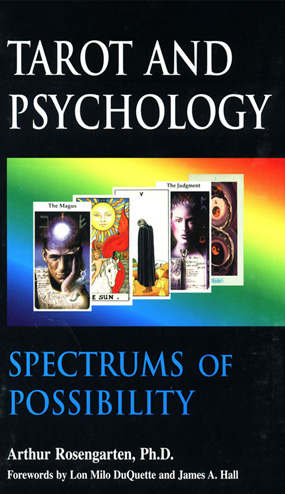
What experts have said about Tarot and Psychology: Spectrums of Possibility:
“A deliciously rich exploration of the Tarot. Never have I seen the Tarot’s deep wealth of meaning uncovered and explained with such skilled and loving intelligence.”
-Allan Combs, author of Synchronicity: Science,
Myth, and the Trickster and The Radiance of Being
“Arthur Rosengarten’s Tarot And Psychology: Spectrums of Possibility joins Sally Nichols’ Jung and Tarot and Irene Gad’s Tarot and Individuation as the third major book on Tarot from a Jungian perspective. Spectrums of Possibility combines moving case studies with practical details of exactly how Tarot can be used as a therapeutic tool. There are no apologies here for his acceptance of Tarot as a divinatory tool; instead Rosengarten tries to show even skeptics how divination is rooted in the synchronistic coming together of a questioner’s need with the layout of the Tarot.
More than any other book to date, it also provides a deep theoretical examination of how this synchronicity is inherent in the archetypal symbolism of the Tarot. An important and useful book.”
– Robin Robertson, Ph.D., author of Jungian Archetypes
“What happens when psychic arts meet scientific methodologies, when prediction marries meaning, when image and empiricism come together? In this radical breakthrough and brilliant masterwork, Art Rosengarten merges Tarot’s 600 years of psycho-socio-cultural symbol-encoding with the newer discipline of psychology…I predict a major success, and a turning point for Tarot as well as for psychologists who pioneer the use of this demonstrably valuable resource.”
– Mary K. Greer, author of Tarot For Your Self, Tarot Mirrors, and Tarot Constellations
To receive a Tarot Consultation with Dr. Rosengarten:
-Readings. Single 90 minute readings cost $155 (by phone or office), payment by cash or credit card. For the Psychological Tarot Series (1) sign up for five 90 minute readings over the course of three months. As with dream interpretation, a series of readings track and elucidate ongoing life themes and struggles during periods of transition providing a rich window from which to open awareness to the natural intelligence stimulated by this process-oriented therapy. Particular cards and symbol patterns will repeat over weeks and months of exploration, and one experiences a special connection to deeper spheres of their psychological life. Journal work may be recommended as well as other homework exercises in depth psychology that will be incorporated and discussed in your next session. Cost $625. Office or phone sessions can be arranged to accomodate your schedule. Call Dr. Rosengarten to discuss this therapeutic process further. (760) 944-6710
 The human psyche is as fascinating as it is complex. Understanding it is a major goal of psychologists, as well as anyone engaged in self-inquiry. There are many approaches one can take, and many tools that can help. Tarot is one such tool that is gaining in popularity as a way to support and and facilitate personal understanding. As Dr. Arthur Rosengarten wrote in his classic book, Tarot and Psychology: Spectrums of Possibility:
The human psyche is as fascinating as it is complex. Understanding it is a major goal of psychologists, as well as anyone engaged in self-inquiry. There are many approaches one can take, and many tools that can help. Tarot is one such tool that is gaining in popularity as a way to support and and facilitate personal understanding. As Dr. Arthur Rosengarten wrote in his classic book, Tarot and Psychology: Spectrums of Possibility:
“The Tarot is a remarkable collection of images and symbols that picture multidimensional themes of universal human experience. With a random series of cards properly interpreted in pre-designated positions (a spread), the intuitive observer will be surprised by the amazing subtlety and sophistication with which this method facilitates self-reflection, deep insight, and spiritual wisdom. Contrary to a habitual Western mental reflex, in practice the placing of supreme trust in the natural intelligence that collects momentarily around events awakens a unique, non-linear, mode of perception through what we respectfully call ‘sacred’ or ‘empowered’ randomness. Loosely speaking, this is what is meant by ‘divination’ and is how the Tarot method is set in motion.”
Art’s innovative methods of interpretation developed over decades of teaching and practice as a Jungian-based psychologist are designed to blend your own intuitions with some understanding of the established system of Tarot, its many applications, curiosities, and dimensions. (Below) Samples from the Rohrig Tarot:
Art Rosengarten’s highly acclaimed book and deck can be purchased on this site or on Amazon.com
To order an autographed book & deck Combo Package: Tarot and Psychology: Spectrums of Possibility ($20) PLUS –Tarot of the Nine Paths: Advanced Tarot for the Spiritual Traveler (box set $39.95) COMBO only $55.00 plus shipping and handling. Call (760) 944-6710 or email: artrosengarten@earthlink.net. Also available at Amazon and other booksellers.
Tarot of the NIne Paths: Samples from Art’s deck TNP which was crafted entirely out of Jungian Sandplay miniatures in his office:
-Relationships: Know Your TYPE (MBTI)
Know Your Jungian Personality Type, that is. It will help you better understand your own personality tendencies, style, strengths and weaknesses as well as areas for growth, improvement, or greater self-acceptance. It will also give you critical insight into the personality tendencies and style of people you are in relationship with, and better ways to communicate with them.
Your Myers-Briggs Type Indicator (MBTI)
Take this free online Jungian Typology Test based on MBTI (Myers-Briggs Personality Indicator) to learn more about your natural personality style. A useful tool in in both individual or couples therapy to help understand important thinking styles, similarities and differences.
NOTE: There are no “right or wrong” answers; if you’re not sure which response is more accurate, go with the answer you feel best reflects who you’ve been over the past year or who you are at rest. This survey is based on the Myers-Briggs Type Indicator (MBTI), the most widely-used type test in the world. It is not meant to label or reduce your full complexity and individuality. It gives important information about how you tend to perceive events, approach social situations, your strengths and weaknesses, and decision-making styles. If coming in for counseling, bring your results into our session and we can discuss them further.
As an example, below are Dr. Rosengarten’s MBTI results/profile after recently taking this test:
Idealist: Portrait of the Counselor (INFJ) Introverted Intuitive Feeling Type with a Preference for Judgment
Counselors have an exceptionally strong desire to contribute to the welfare of others, and find great personal fulfillment interacting with people, nurturing their personal development, guiding them to realize their human potential. Although they are happy working at jobs (such as writing) that require solitude and close attention, Counselors do quite well with individuals or groups of people, provided that the personal interactions are not superficial, and that they find some quiet, private time every now and then to recharge their batteries. Counselors are both kind and positive in their handling of others; they are great listeners and seem naturally interested in helping people with their personal problems. Not usually visible leaders, Counselors prefer to work intensely with those close to them, especially on a one-to-one basis, quietly exerting their influence behind the scenes.
Counselors are scarce, little more than one percent of the population, and can be hard to get to know, since they tend not to share their innermost thoughts or their powerful emotional reactions except with their loved ones. They are highly private people, with an unusually rich, complicated inner life. Friends or colleagues who have known them for years may find sides emerging which come as a surprise. Not that Counselors are flighty or scattered; they value their integrity a great deal, but they have mysterious, intricately woven personalities which sometimes puzzle even them.
Counselors tend to work effectively in organizations. They value staff harmony and make every effort to help an organization run smoothly and pleasantly. They understand and use human systems creatively, and are good at consulting and cooperating with others. As employees or employers,Counselors are concerned with people’s feelings and are able to act as a barometer of the feelings within the organization. Blessed with vivid imaginations, Counselors are often seen as the most poetical of all the types, and in fact they use a lot of poetic imagery in their everyday language. Their great talent for language-both written and spoken-is usually directed toward communicating with people in a personalized way. Counselors are highly intuitive and can recognize another’s emotions or intentions – good or evil – even before that person is aware of them. Counselors themselves can seldom tell how they came to read others’ feelings so keenly. This extreme sensitivity to others could very well be the basis of the Counselor’s remarkable ability to experience a whole array of psychic phenomena. Mohandas Gandhi, Sidney Poitier, Eleanor Roosevelt, Jane Goodall, Emily Bronte, Sir Alec Guiness, Carl Jung, Mary Baker Eddy, Queen Noor are examples of the Counselor Idealist (INFJ).
In relationships, INFJs are warm and affirming people who are usually also deep and complex. They’re likely to seek out and promote relationships that are intense and meaningful. They tend to be perfectionists, and are always striving for the Ultimate Relationship. For the most part, this is a positive feature, but sometimes works against the INFJ if they fall into the habit of moving from relationship to relationship, always in search of a more perfect partner. In general, the INFJ is a deeply warm and caring person who is highly invested in the health of their close relationships, and puts forth a lot of effort to make them positive. They are valued by those close to them for these special qualities. They seek long-term, lifelong relationships, although they don’t always find them.
-THE TEMPLATE: On Meeting Halfway: Sage Advice From the I Ching
Read the timeless advice below adapted from the ancient Chinese Book of Changes or I Ching. Hexagram 44 “Coming To Meet” skillfully describes a therapeutic strategy that empowers all living systems (including all interpersonal relationships, marriage, family, and work relationships) towards their natural states of completion, well-being, aliveness, and wholeness. As a therapist I adapt these principles in counseling as a template for positive relationship growth and change and can help you to apply these basic principles to your own unique situations.
HEXAGRAM 44
On “MEETING HALFWAY”
“Coming to meet halfway is possible only between people who are mutually honest and sincere in their way of life.” I Ching
Key Points:
1. The hexagram describes a “correct” relationship as one in which two people come to meet each other halfway. Halfway means that both are open and receptive to each other. It must be mutually voluntary.
2. We must maintain reserve in our relationships until the coming to meet is mutual. Maintaining “reserve” is the correct action (or nonaction) during turbulence and communication breakdown
3. Coming to meet halfway is possible only between people who are mutually honest and sincere in their way of life. It is the great joy of such relationships that they are full of mutual trust and sensitivity
4. “Coming to meet” is best understood as a contract made between two people. If one is indolent in performing his part, or has mental reservations about what he is willing to do, the contract may fail. Although such a person may have entered the contract without any immediate objections, his attitude may contain objections which arise only at the time his obligations are to be performed. Such a person may secretly feel that contracts are not to be taken seriously, or, on seeing how difficult it is to fulfill his part, he may hedge on doing it because of some idea that all contracts are subject to fitting into his concept of what is “reasonable.”
5. It is impossible to come to meet such a person halfway and it is better for us to go on our way alone and to wait until the fundamentals of unity are firmly established before we commit ourselves to other people.
6. When we cater to another person’s ego because it is uncomfortable to go on our way alone, we choose the high road of comfort rather the low road of modesty and loneliness. Withdrawal from the high road is the action often counseled by the I Ching (The Classic Chinese Book of Changes).
7. If a person is treating us presumptuously, and if we remind him (or her) of this, he may correct his habits for a few days, but gradually revert to the same pattern of neglect. This he does from egotistical indolence (apathy), something in his point of view makes him feel he has the right to be indifferent.
8. Likewise, we must withdraw from the indolent person, “cutting our inner strings” of attachment to him, and no longer look at his wrongdoings with our inner eye (preoccupations, self talk, ideations etc.).
9. This enables the person to see what he is doing in the mirror created by the void. By dispersing any alienation we may feel, we also lend strength to his superior self. Momentarily, his ego is overcome. We need to realize that his change is short-lived, but it is an essential beginning. The change does not last because it is only founded on his response to feeling the void. It becomes permanent change when he sees clearly that unity with others depends upon his devoting himself to correcting his mistakes. Only then can we abandon a more formal way of relating to him.
10. The sense of loss, loneliness, or poverty of self a person feels on our withdrawing from him is called “punishment” (in the I Ching), but I prefer the term “mindful disengagement.” Mindful disengagement works only if it is applied in the way described—we must consistently and immediately withdraw, neither contending with him nor trying to force progress by leverage. We withdraw accepting his state of mind, letting him go. We must take care not to withdraw with any other attitude than that required to maintain inner serenity, and to keep from “giving up on” him (or her).
11. If on the other hand we withdraw with feelings of alienation, or of self-righteousness, our ego is involved as the punisher. The ego lacks “the power and authority” to punish. The culprits not only do not submit, but “by taking up the problem the punisher arouses poisonous hatred against himself.” One person’s ego may not punish another person’s ego.
12. When a person returns to the path of “responding correctly” (being open and receptive) we likewise go to meet him (or her) halfway, rather than tell him he is doing things correctly. In this way he comes to relating correctly from his own need to relate correctly and we do not force it on him. Our consistence and discipline in feeling out each moment and responding to it does the work.
13. It is unnecessary to watch a person’s behavior to see if he is becoming worse or better; we need only be in tune with ourselves. Our inner voice warns us precisely when to withdraw and when to relate. We need only listen within.
14. It is important to work with a situation only so long as the other person is receptive and open, and to retreat the instant this receptivity wanes. When we understand that this represents a natural circle of influence, we learn to “let go” when the moment of influence passes, and not to press our views. This gives other people the space they need to move away from us and return of their own accord.
15. We must avoid egotistical enthusiasm when we think we are making progress, or discouragement when the dark period ensues. Throughout the cycle we learn to remain detached. Holding steadily to the light within us and within others. The instant we strive to influence, we “push upward blindly.” If we insist on accomplishing the goal at all costs, our inner light is darkened and our will to see things through is damaged.
16. The strength of a person’s ego corresponds to the amount of attention it can attract. On the most simple level this recognition is by eye-to-eye contact; on the more basic inner level we strengthen other people’s egos by watching them with our inner eye. Only when we withdraw both our eye-to-eye contact and our inner gaze do we deprive his ego of its power—“We cannot lead those whom we follow.”
17. Inner withdrawal is an action of perseverance that has its own reward, but only when it is modest perseverance, not an attempt to impress others by getting them to notice our withdrawal. In many situations the problem is resolved, not through any external action that arises spontaneously on our part, but by simply “letting it happen,” through letting go of the problem. Our “action” is to “let go.”
_____________________________________________________________________
I whole-heartedly subscribe to this elegant strategy of “meeting halfway” as a template for modern relationships. I can help you implement needed changes and fine-tune where necessary in ways. Contact me at Moonlight Counseling (760) 944-6710 to set up an appointment.
Adapted from the essay: “Coming To Meet: Advice From The I Ching,” by Carol Anthony, [included in the anthology, Challenge Of The Heart, John Welwood, Shambhala).
